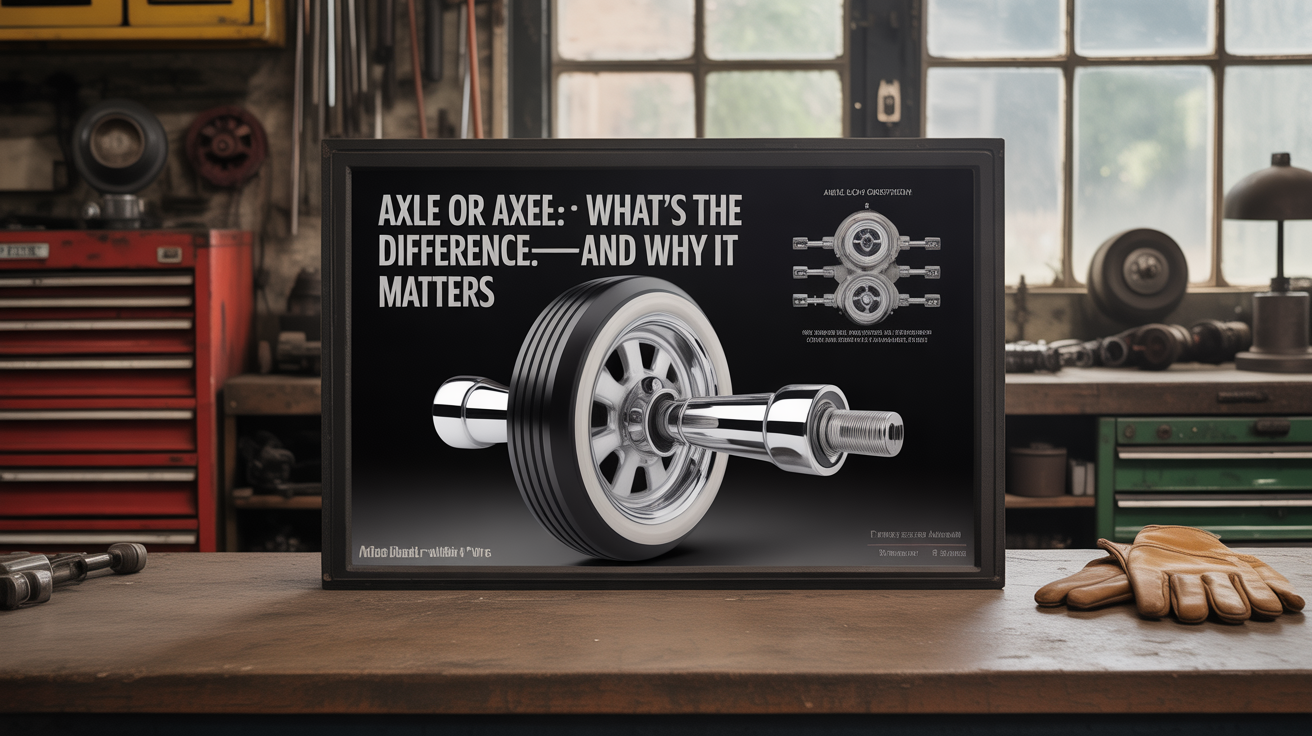Misusing axle and axel may seem harmless. However confusing a mechanical component with a figure skating jump can undermine your writing or sabotage technical accuracy. This guide explores axle vs axel, explains pronunciation similarity, and gives you tools to use each word correctly. You’ll gain clarity on spelling, context, and usage—a valuable precision boost for any writer, sports fan, or mechanical enthusiast.
What Does Axle Mean? The Mechanical Component
An axle is a metal shaft for wheel rotation or support. You’ll find axles in nearly all vehicle wheel assemblies—from cars, trucks, and trailers to bicycles and farming equipment.
Axles support the vehicle’s weight and transmit driving torque. If an axle breaks on a truck, the wheel might seize or come off entirely, causing danger. Automotive parts catalogs always list axle, never axel. This precision underscores its mechanical context.
Read More About This Article: Simile vs Metaphor: What’s the Difference and How to Use Them Effectively
Related Terminology
- Drive axle, half-shaft, dead axle
- Found in transmissions, differentials, and chassis
Quick Clarifier
Imagine a toy car. The rod that holds wheels is the axle. That’s mechanics, engineering, and real-world physics.
What Is an Axel? The Figure Skating Jump
An axel, spelled with an e, refers exclusively to the figure skating jump that begins with a forward edge takeoff.
Named after Norwegian skater Axel Paulsen, the axel jump carries a legacy. That’s why we capitalize the first letter in figure skating discussions. When a commentator mentions a “triple axel,” they envision a skater launching forward and spinning three times before landing backward.
Axel Variations
- Single, double, triple, quad axel
- Grew in complexity as skaters pushed athletic boundaries
Skate Jump Terminology
- Axel: only jump with forward edge takeoff
- Other jumps (like toe loop or lutz) use different edges and entry techniques
In sportswriting or broadcasting, avoiding an axle reference ensures clarity.
Axle vs Axel: Spotting the Differences
These two terms look and sound alike—so that’s where mistakes hide. Here’s how to differentiate them clearly:
| Feature | Axle (Mechanical Component) | Axel (Figure Skating Jump) |
|---|---|---|
| Spelling | A‑X‑L‑E | A‑X‑E‑L |
| Meaning | Shaft for wheel rotation | Rotational skating jump |
| Field of Use | Automotive, engineering | Figure skating, sports journalism |
| Etymology | Old English eax (axis) | Named after Axel Paulsen |
| Pronunciation | /ˈæk.səl/ | /ˈæk.səl/ |
| Common Mistake Context | Writers mix with sports writing | Writers mix with mechanical writing |
Why People Confuse Axle and Axel
- Common homophones: They sound identical—even though letters swap
- Domain unawareness: Non-skaters don’t know axel. Mechanics don’t know axle
- Spelling difference just one letter apart
- Quick typing errors: letters misplaced in haste
Avoiding the Mix-Up:
- Pay attention to context—vehicle or sports
- Use memory tricks (see next section)
- Read aloud to confirm accuracy
Mnemonic Aids to Keep Them Straight
Use these memory tricks to lock in your word choice:
- Axle: Think of “X” like X‑ray cars rolling on axles
- Axel: One “E” for Elegance in skating, named after Axel Paulsen
Alternate strategy: Temporarily replace with a close synonym in your draft:
- “Shaft” for axle → Does that make sense in context?
- “Jump” for axel → Does that fit the sentence?
If yes, you’ve got the right word.
Real Usage Examples You Won’t Mix Up
Correct Sentences
- The rear axle failed on my SUV during the trip.
- She landed a double axel cleanly at the championship.
Incorrect Swap Mistakes
- ❌ “The axel of the car needs tightening.”
- ❌ “She landed a double axle jump on ice.”
Used correctly, each word brings clarity, precision, and credibility.
Historical and Etymological Roots
- Axle traces back to Old English eax, meaning axis. It’s firmly technical, not borrowed from a name.
- Axel, by contrast, honors Axel Paulsen, the skater who performed the first forward-takeoff jump in the 1880s.
Only axel comes from a personal name. That distinction underscores their separate worlds.
Real-Life Case Studies & Credibility Errors
Automotive Catalog Error
A parts catalog once listed “front axel,” leading buyers to confusedly order the wrong part. That mistake cost money and frustrated readers.
Sports Broadcast Blunder
A TV commentator said “axle jump,” prompting eye rolls from skating experts. Sportswriting demands correct terminology to maintain trust.
Lesson: Precision matters. One letter difference changes field entirely.
Writing with Clarity: Tips for Editors and Writers
Domain Check
Ask: Is this sentence about a car or a skater?
- If mechanical → axle
- If athletic jump → axel
Proofreading Strategies
- Use a custom dictionary to flag axel outside sports context
- Read text aloud and listen for mismatch
- Replace with synonyms like shaft or jump to test
Consistency matters. One misuse undermines your authority.
Answering Common Questions (FAQ)
- Can “axel” ever mean a mechanical part?
No. Axel strictly refers to the skating jump. - Is “axel” acceptable in British or US English for vehicles?
Absolutely not. Use axle for cars and similar machinery. - How can you teach kids the difference?
Use real-world props: toy cars for axle, skating videos for axel. Reinforce the spelling and context.
Final Thoughts: Precision Counts
In writing, clarity and precision matter. Confusing axle vs axel betrays lack of care—especially in technical writing or sports journalism.
Whether you’re describing a car’s wheel assembly or announcing a triple jump on ice, choose your word carefully. One letter makes all the difference.
This guide equips you to use axle and axel confidently. Know the domain, apply the memory tricks, proofread with purpose—and your writing will remain sharp, accurate, and credible.

